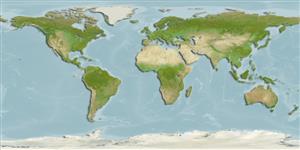Holocéphales (chimères) (chimaeras) >
Chimaeriformes (Chimaeras) >
Chimaeridae (Shortnose chimaeras or ratfishes)
Etymology: Chimaera: Named for the mythological creature composed of parts of multiple animals, referring to their odd mix of characteristics. (See ETYFish); orientalis: Latin for eastern, the first Chimaera described from the eastern Pacific Ocean. (See ETYFish).
Environment: milieu / climate zone / depth range / distribution range
Écologie
marin bathydémersal; profondeur 560 - 1138 m (Ref. 97389). Deep-water
Distribution
Pays | Zones FAO | Écosystèmes | Occurrences | Point map | Introductions | Faunafri
Eastern Pacific: Costa Rica and Peru; probably more widely distributed in the eastern Pacifc region.
Taille / Poids / Âge
Maturity: Lm ? range ? - ? cm
Max length : 17.6 cm TL mâle / non sexé; (Ref. 97389)
Description synthétique
Morphologie | Morphométrie
This species is distinguished from its congeners by having an anal fin; also by the following set of characters: the oral and preopercular canals share a short common branch off the infraorbital canal; long dorsal spine (DSA 28.4-31.0% BDL), longer than first dorsal fin, when depressed reaches beyond to origin of second dorsal fin; first dorsal fin is high (D1H 20.8-26.7% BDL) with a short base (D1B 10.3-12.5% BDL); long interdorsal space (IDS 8.1-10.2% BDL); long pectoral fin (P1A 40.0-43.5% BDL), when depressed reaches beyond origin of pelvic fin base; long pelvic claspers (CLT 17.5-17.7% BDL), bifurcate, divided at about distal 40.9-43.1% of its length; long dorsal caudal space (DCS 2.0-2.5% BDL); ventral caudal margin ending slightly posterior to dorsal caudal margin; coloration dark brown with ventral portion of the trunk and all fins slightly darker, without distinctive markings or mottling (Ref. 97389).
Life cycle and mating behavior
Maturité | Reproduction | Frai | Œufs | Fécondité | Larves
Angulo, A., M.I. López, W.A. Bussing and A. Murase, 2014. Records of chimaeroid fishes (Holocephali: Chimaeriformes) from the Pacific coast of Costa Rica, with the description of a new species of Chimera (Chimaeridae) from the eastern Pacific Ocean. Zootaxa 3861(6):554-574. (Ref. 97389)
Statut dans la liste rouge de l'IUCN (Ref. 130435)
Menace pour l'homme
Harmless
Utilisations par l'homme
Pêcheries:
Plus d'informations
PaysZones FAOÉcosystèmesOccurrencesIntroductionsStocksÉcologieRégime alimentaireÉléments du régime alimentaireConsommation alimentaireRation
Noms communsSynonymesMétabolismePrédateursÉcotoxicologieReproductionMaturitéFraiRassemblement de ponteFéconditéŒufsDéveloppement de l'œuf
Taille/ÂgeCroissanceLongueur-poidsLongueur-longueurFréquences de longueursMorphométrieMorphologieLarvesDynamique des populations larvairesRecrutementAbondanceBRUVS
RéférencesAquacultureProfil d'aquacultureSouchesGénétiqueElectrophoresesHéritabilitéPathologiesTraitementNutrientsMass conversion
CollaborateursImagesStamps, Coins Misc.SonsCiguateraVitesseType de nageSurface branchialeOtolithesCerveauxVision
Outils
Articles particuliers
Télécharger en XML
Sources Internet
Estimates based on models
Phylogenetic diversity index (Ref.
82804): PD
50 = 0.5000 [Uniqueness, from 0.5 = low to 2.0 = high].
Bayesian length-weight: a=0.00282 (0.00118 - 0.00673), b=3.10 (2.89 - 3.31), in cm total length, based on LWR estimates for this (Sub)family-body shape (Ref.
93245).
Niveau trophique (Ref.
69278): 3.4 ±0.5 se; based on size and trophs of closest relatives
Résilience (Ref.
120179): Faible, temps minimum de doublement de population : 4,5 à 14 années (Deep-water species with low fecundity (RF).).
Fishing Vulnerability (Ref.
59153): Low vulnerability (10 of 100).
